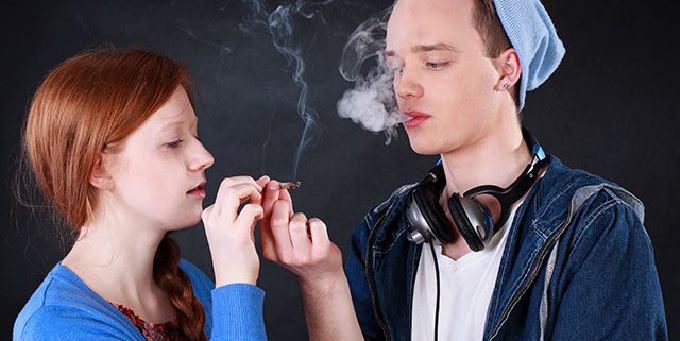
France is one of the European countries where adolescents consume the most narcotics. 80% of them experiment several products – tobacco, alcohol and cannabis, according to the figures of the French Observatory of the drugs and the addiction. One in four 15-year-olds, and almost one in two at 17, has already touched cannabis. As for regular use, it concerns one in ten adolescents (9.2%). But from the age of 25, epidemiological surveys show that these rates decrease considerably. The use of cannabis therefore remains primarily a generational phenomenon.
If these figures, reflecting a real public health problem, may legitimately worry parents, they also show the non-tragic nature of these uses, most of them reversible. They suggest that cannabis use is a life-time risk that can impact young people’s schooling and social relationships, and in some cases become chronic addiction into adulthood. Putting these risks in perspective gives adults back their power to act and reinforces their role as educators, in a dual approach of reducing these risks and supporting the person.
The choice of prevention
How to best place the cursor between protection and autonomy, without leaving the adolescent alone in his search for pleasure, performance and social integration? How can one avoid entrusting the object with the power of calming, accentuating and enhancing the attractiveness of psychoactive substances? It is to these questions that we tried, Jean-Pierre Courteron, Aude Stehelin and myself, to answer with Adolescents and cannabis, what to do? (Couteron, Lascaux & Stehelin, 2017). In this book published in 2017, we have chosen to share the experiences and knowledge from our clinical practices in Consultations Jeunes Consommateurs and our academic work, in connection with a European research program (INCANT). Objective: to allow everyone to draw attitudes and strategies that he will adapt to the situations encountered, to better build his own know-how.
Everyone agrees that we need to “keep the dialogue going and put a framework”. A very good advice but usually difficult to put into practice. Initiating a dialogue on “drugs”, still possibly taboo subject – and moreover when it comes to his own child – is a challenge! The psycho-educational approach adopted aims to help parents and adults to dive without fear, step by step, in the construction of a preventive education.
The art of engaging in dialogue
The emotional reaction that follows the discovery of a use may lead to attitudes that have the opposite effect of the intended purpose. For a parent, putting anxiety or anger at bay is a real challenge. To achieve this, we can play on three registers:
- Perceptions: Accept the difference of perception with your teenager to avoid sterile debates like “I manage / no you exaggerate”! The adolescent needs this differentiation to develop, and it does not augur for the adult that he will be and the values he will defend. It is by restarting the process that the gap will then be reduced.
- The objectives: To change target of attack, cannabis is only a means found by him (certainly not ideal) to feel better, not a way to destroy himself. So, more than fighting “against”, let’s look at the adolescent’s pursuit of wellness.
- Personal Interactions: Avoid some communication pitfalls to which adolescents are particularly sensitive, they feel devalued. To want to convince prevents from listening, to want to return to the reason does not help to “hear” its reasons, to be trapped in a moralizing thought well / badly reduced the opening to possible ones.
The time of awareness
To change the adolescent’s eyes on its uses, two types of action, classic on other themes, to avoid the trap of reproach. They simply need to be adapted to this case:
- Active Listening: Interventions of the type “you do not need this with your friends, do not be influenced” become “what does consumption bring you when you are with your friends? By questioning what the adolescent shows by behaviors, he will feel more valued and therefore more willing to listen to us.
- Empowerment: Developing an active listening to what the teenager is going through and the functions of his use should not prevent adults from “framing” their empowerment. Interventions of the type “you are not able to stop, you ruin everything” become “what are the consequences of this or that behavior? What risks do you take? Reformulating things in terms of rules and consequences for him and other family members, rather than in terms of prohibition and authorization, helps identify his limits and control abilities.
Keep the direction
It’s about “staying confident about what’s been built, while staying alert”. Because positive changes in use are not always visible immediately, parents or educators will have to deal with anxieties related to changes and doubts:
By managing the inevitable and necessary conflicts through negotiation, no winners or losers – because a teenager who is willing to negotiate is a teenager who changes!
By accurately naming the observed efforts (rather than trying to say what is right or wrong) to encourage change. This builds self-confidence and counterbalances the positive effects of the product.
By remaining vigilant to the risks of relapse, which are part of the normal process of change, and defining for example safeguards with the teen to act quickly.
If the example in this manual is that of cannabis, psycho-educational education is valid for all addictive risk experiments of adolescents. It soothes the emotional load because it informs, advises and gives back a power to act to parents, educators. It is a necessary passage to question, to understand, to arm yourself against these educational challenges essential for the future of adolescents. Without giving a lesson, let’s share know-how and know-how for educational cooperation!
Author Bio: Muriel Lascaux is a Doctor in Psychology, Institut d’Enseignement à Distance (IED) at Université Paris 8
